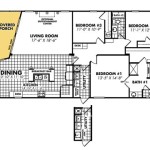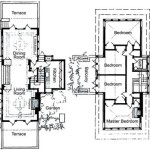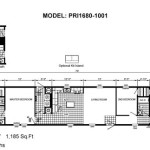Craftsman Style Home Plans: The Enduring Appeal of One-Story Designs
The Craftsman style, an architectural movement that emerged from the British Arts and Crafts movement in the late 19th and early 20th centuries, continues to resonate with homeowners seeking a blend of simplicity, functionality, and aesthetic beauty. Characterized by its emphasis on natural materials, handcrafted details, and open floor plans, the Craftsman style offers a timeless appeal. Within this broad architectural category, one-story Craftsman homes hold a particular allure, providing accessibility, convenience, and a seamless connection to the surrounding landscape.
This article will examine the key features of one-story Craftsman home plans, delving into their advantages, exploring their historical context, and highlighting elements that contribute to their lasting popularity. It will also provide insights into adapting these plans to modern lifestyles while preserving the integrity of the original design principles.
The Defining Characteristics of One-Story Craftsman Homes
One-story Craftsman homes distinguish themselves through several defining characteristics, many of which are directly related to the limitations and opportunities presented by their single-level design. Key among these are the emphasis on horizontality, the prominent use of natural materials, and the careful integration of interior and exterior spaces.
Horizontality is a critical aesthetic element. Low-pitched rooflines, often with wide eaves and exposed rafters, contribute to a sense of groundedness and visual stability. These roofs are typically gabled or hipped, providing attic space for storage or potential future expansion. Wide front porches, supported by substantial tapered columns or piers, further emphasize the horizontal lines and create a welcoming entry space. The porch serves as a transitional zone, blurring the boundaries between the interior and the exterior.
The use of natural materials is paramount to the Craftsman aesthetic. Wood, stone, and brick are employed extensively, both structurally and decoratively. Wood siding, often in the form of clapboard, shingles, or board-and-batten, is a common exterior cladding. Stone or brick is frequently used for foundation walls, porch piers, and chimney stacks, adding texture and visual interest. Inside, wood trim, including wainscoting, picture rails, and built-in cabinetry, showcases the inherent beauty and warmth of the material.
Integrating interior and exterior spaces is another hallmark of one-story Craftsman designs. Large windows, often arranged in groupings or with decorative grids, allow ample natural light to flood the interior and provide views of the surrounding landscape. French doors or sliding glass doors leading from living areas or bedrooms to patios or decks facilitate indoor-outdoor living, creating a seamless flow between the home and its environment. The orientation of the home on the lot is also carefully considered to maximize sunlight exposure and take advantage of natural breezes.
Beyond these fundamental characteristics, one-story Craftsman homes often incorporate other distinctive features, such as dormers for added attic light and ventilation, window boxes filled with colorful flowers, and handcrafted details like stained glass accents and decorative hardware. The overall effect is a home that exudes warmth, character, and a strong connection to nature.
The Advantages of Single-Level Living in a Craftsman Style
The popularity of one-story Craftsman homes stems not only from their aesthetic appeal but also from the practical advantages they offer. These advantages are particularly relevant to specific demographic groups, including families with young children, individuals with mobility challenges, and aging homeowners seeking to simplify their lives.
Accessibility is a primary benefit of single-level living. The absence of stairs eliminates a significant barrier to entry for individuals with mobility limitations, making the home more accessible for wheelchair users, people with joint pain, and those who simply prefer to avoid the strain of climbing stairs. This accessibility also extends to everyday tasks, such as carrying groceries or laundry, which become easier to manage without the need for vertical transport. Furthermore, a one-story layout can be easily adapted to accommodate future accessibility needs, such as the installation of grab bars or wider doorways.
Convenience and ease of maintenance are also significant advantages. A single-story home simplifies cleaning and maintenance tasks, as there are no stairs to vacuum or windows to clean on multiple levels. This can be a particularly attractive feature for busy homeowners or those who prefer to spend their time on other pursuits. Furthermore, the reduced exterior surface area of a one-story home can translate to lower energy costs, as there is less wall space exposed to the elements. Maintenance tasks like gutter cleaning and roof repairs are also generally easier to perform on a single-story structure.
Enhanced connection to the outdoors is another key benefit. One-story Craftsman homes often feature expansive porches, patios, and gardens that are easily accessible from within the home. This seamless integration of indoor and outdoor spaces encourages homeowners to spend more time outside, enjoying the fresh air and sunshine. The single-level layout also makes it easier to supervise children playing in the yard or to entertain guests in an outdoor setting. The horizontal emphasis of the design complements the surrounding landscape, creating a harmonious relationship between the home and its natural environment.
Finally, one-story living can promote a sense of intimacy and connection within the family. The open floor plans that are characteristic of Craftsman homes encourage interaction and communication among family members. Parents can easily keep an eye on children, and family gatherings can flow seamlessly from one room to another. The absence of stairs also eliminates the potential for noise transmission between floors, creating a more peaceful and harmonious living environment.
Adapting One-Story Craftsman Plans for Modern Living
While the classic Craftsman style remains highly desirable, it is often necessary to adapt these plans to meet the needs of contemporary lifestyles. This adaptation can involve incorporating modern amenities, optimizing space utilization, and incorporating sustainable design principles, all while preserving the essential character of the original Craftsman aesthetic.
Integrating modern amenities is a key aspect of adapting Craftsman plans. This may involve incorporating energy-efficient appliances, smart home technology, and updated plumbing and electrical systems. Modern kitchens, with their open layouts, ample counter space, and high-end appliances, are often integrated seamlessly into the Craftsman design. Bathrooms are also updated with modern fixtures and finishes, while retaining the warmth and charm of the Craftsman style through the use of natural materials and handcrafted details.
Optimizing space utilization is particularly important in one-story homes, where the footprint is limited. Open floor plans are often employed to create a sense of spaciousness and to maximize natural light. Flexible spaces that can be used for multiple purposes, such as a home office that can also serve as a guest room, are also highly desirable. Built-in storage solutions, such as bookcases, cabinets, and window seats, are used to maximize storage space without compromising the aesthetic appeal of the home. The careful placement of windows and doors can also enhance the flow of space and create a more inviting and functional living environment.
Incorporating sustainable design principles is increasingly important in modern home design. This may involve using environmentally friendly building materials, such as recycled wood or bamboo flooring, and incorporating energy-efficient features, such as solar panels and rainwater harvesting systems. Proper insulation and ventilation are also crucial for reducing energy consumption and creating a healthy indoor environment. Landscaping with native plants can minimize water usage and create a more sustainable and ecologically friendly yard. The integration of these sustainable design principles not only reduces the environmental impact of the home but also enhances its long-term value and livability.
Maintaining the architectural integrity of the Craftsman style is of utmost importance when adapting these plans. This involves preserving the key features of the design, such as the low-pitched roofline, wide eaves, exposed rafters, and the use of natural materials. The handcrafted details that are characteristic of the Craftsman style, such as stained glass accents, decorative hardware, and custom millwork, should also be preserved or replicated. The overall goal is to create a home that is both modern and functional while remaining true to the spirit of the original Craftsman design.
Careful consideration must be given to the selection of exterior finishes, such as siding, roofing, and paint colors. Earthy tones and natural color palettes are typically used to complement the surrounding landscape and to create a sense of harmony. The use of contrasting trim colors can highlight the architectural details of the home and add visual interest. The choice of landscaping elements, such as trees, shrubs, and flowers, can also enhance the curb appeal of the home and create a welcoming and inviting atmosphere.
In conclusion, one-story Craftsman home plans offer a compelling combination of aesthetic appeal, functional design, and practical advantages. Their emphasis on natural materials, handcrafted details, and open floor plans creates a warm, inviting, and comfortable living environment. By carefully adapting these plans to meet the needs of modern lifestyles, homeowners can enjoy the timeless beauty and enduring appeal of the Craftsman style for generations to come. The ability to adapt these plans while maintaining historical integrity is a testament to the enduring design quality of the Craftsman movement.

Craftsman Style House Plans Big And Small Houseplans Blog Com
:max_bytes(150000):strip_icc()/SL-1444_FCR-6feba1b011944212b854a6aabde38158.jpg?strip=all)
These One Story Craftsman House Plans Are Full Of Southern Charm

Single Story Craftsman Home Plans Blog Eplans Com

4 Bedroom 1 Story Modern Farmhouse Style Plan With Outdoor Living Area And Bonus Room Westchester Craftsman House Plans

Modern Craftsman Style Home Plan House Plans Design Floor Dream

One Story Craftsman Style House Plan 7069 Covington

Craftsman Style House Plans Sater Design Collection

Durham Drive Craftsman House Plans Ranch

Sturbridge Ii C 4422 4 Bedrooms And 2 5 Baths The House Designers

Craftsman House Plans Style Home The Designers








